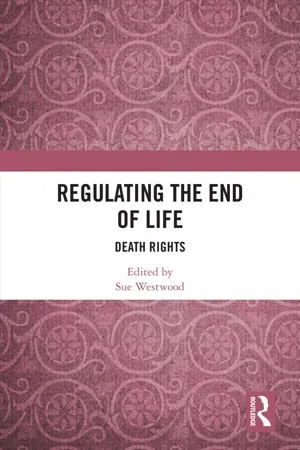
- 256 pages
- English
- ePUB (mobile friendly)
- Available on iOS & Android
About this book
Regulating the End of Life: Death Rights is a collection of cutting-edge chapters on assisted dying and euthanasia, written by leading authors in the field.
Providing an overview of current regulation on assisted dying and euthanasia, both in the UK and internationally, this book also addresses the associated debates on ethical, moral, and rights issues. It considers whether, just as there is a right to life, there should also be a right to death, especially in the context of unbearable human suffering. The unintended consequences of prohibitions on assisted dying and euthanasia are explored, and the argument put forward that knowing one can choose when and how one dies can be life-extending, rather than life-limiting. Key critiques from feminist and disability studies are addressed. The overarching theme of the collection is that death is an embodied right which we should be entitled to exercise, with appropriate safeguards, as and when we choose.
Making a novel contribution to the debate on assisted dying, this interdisciplinary book will appeal to those with relevant interests in law, socio-legal studies, applied ethics, medical ethics, politics, philosophy, and sociology.
Frequently asked questions
- Essential is ideal for learners and professionals who enjoy exploring a wide range of subjects. Access the Essential Library with 800,000+ trusted titles and best-sellers across business, personal growth, and the humanities. Includes unlimited reading time and Standard Read Aloud voice.
- Complete: Perfect for advanced learners and researchers needing full, unrestricted access. Unlock 1.4M+ books across hundreds of subjects, including academic and specialized titles. The Complete Plan also includes advanced features like Premium Read Aloud and Research Assistant.
Please note we cannot support devices running on iOS 13 and Android 7 or earlier. Learn more about using the app.
1 Introducing ‘Regulating the End of Life: Death Rights’
Overview
Context
How this book can be used
- Those who are interested in the broad content can do a straightforward ‘begin at the beginning’ and work their way through.
- Those who are interested in particular themes may wish instead to delve first into specific sections. Part 1 addresses regulatory contexts; Part 2 addresses ethics, morals and values; Part 3 addresses rights; and in Part 4, I take an overview approach, tying all of the chapters together under an overarching claim for the right to die.
- The book includes chapters which take very different approaches. Readers interested in more abstract analyses may be drawn in particular to the chapters by Penney Lewis (Chapter 2), Isra Black (Chapter 7) and Thomas Tierney (Chapter 10). Readers more interested in lived experience may wish to focus on chapters by Alex Ruck Keene (Chapter 3), Ari Gandsman (Chapter 11) and Els van Wijngaarden (Chapter 12) as well as, perhaps, my own final overview chapter (Chapter 14), which asks what an ‘outsider’ perspective (through the eyes of hypothetical aliens) can offer to the ‘right to die’ debate. Readers interested in particular countries’ regulatory approaches will wish to consider Penney Lewis’s overview in Chapter 2; Chapters 3 and 5 for an analysis of the English context; Chapter 4 which relates to Australia; Chapters 10 and 11 which come from the US; Chapter 12 which relates to the Netherlands; and Chapters 9 and 10 which relate to a European context, particularly to the European Convention on Human Rights.
- For those who wish to engage with all authors’ approaches to particular sub-topics, the Index will guide them to the relevant sections. Alternatively, readers can just dip in and out according to their needs/interests.
Definition of terms
Chapter outlines
Part 1: Legal change and challenges
Table of contents
- Cover
- Half Title
- Title Page
- Copyright Page
- Dedication
- Table of Contents
- List of contributors
- 1 Introducing ‘Regulating the End of Life: Death Rights’
- Part I Legal changes and challenges
- Part II Ethics, morals and values
- Part III Rights claims
- Part IV Transgressions
- Index